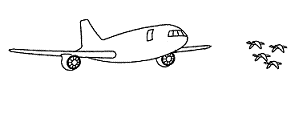Bird Strike Committee Proceedings

Bird Strike Committee-USA/Canada Joint Annual Meeting: 2nd (2000)
Date of this Version
August 2000
Document Type
Article
Abstract
Geese pose a threat to aircraft worldwide. The anthraquinone formula “Flight Control” (FC) is marketed as a deterrent to grazing geese, through an ultraviolet and post-ingestional repellency. The Port of Portland conducted a test to address six objectives regarding the effectiveness of Flight Control. A field with heavy goose activity was divided into five transects, two of which had goose activity 65 percent of the 22 days monitored. These two plots were sprayed using a mixture of one-half gallon of FC, five gallons of water, and eight ounces of an agricultural sticker. This was applied at a rate of one-half gallon per acre. Geese were not observed in the treated areas for the first 10 days. After 10 days, geese were present in the treated plots five of the next 11 days, or 21 percent of monitoring events. At the end of six weeks, treated areas had goose activity in 13 percent of monitoring events, compared to 32 percent in untreated areas. We concluded that Flight Control was an effective goose deterrent on turf with total avoidance for the first 10 days. However, geese did not avoid the entire project site, only the treated plots. Geese also did not learn to avoid treated areas and returned to treated plots as soon as the product had decreased in concentration. There were no adverse effects to non-target birds, or to treated grass. Therefore, FC is an effective temporary goose deterrent for specific areas.

